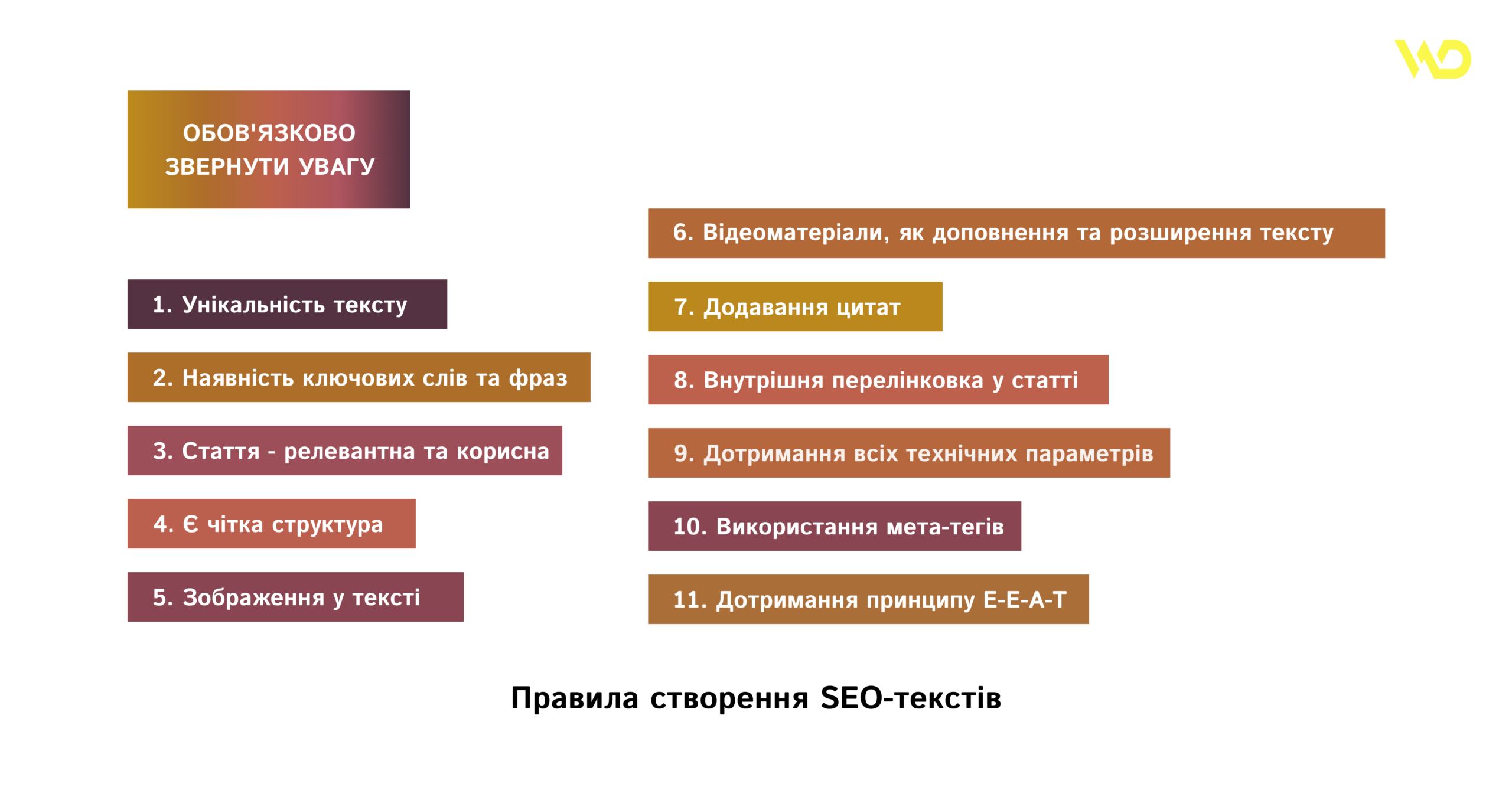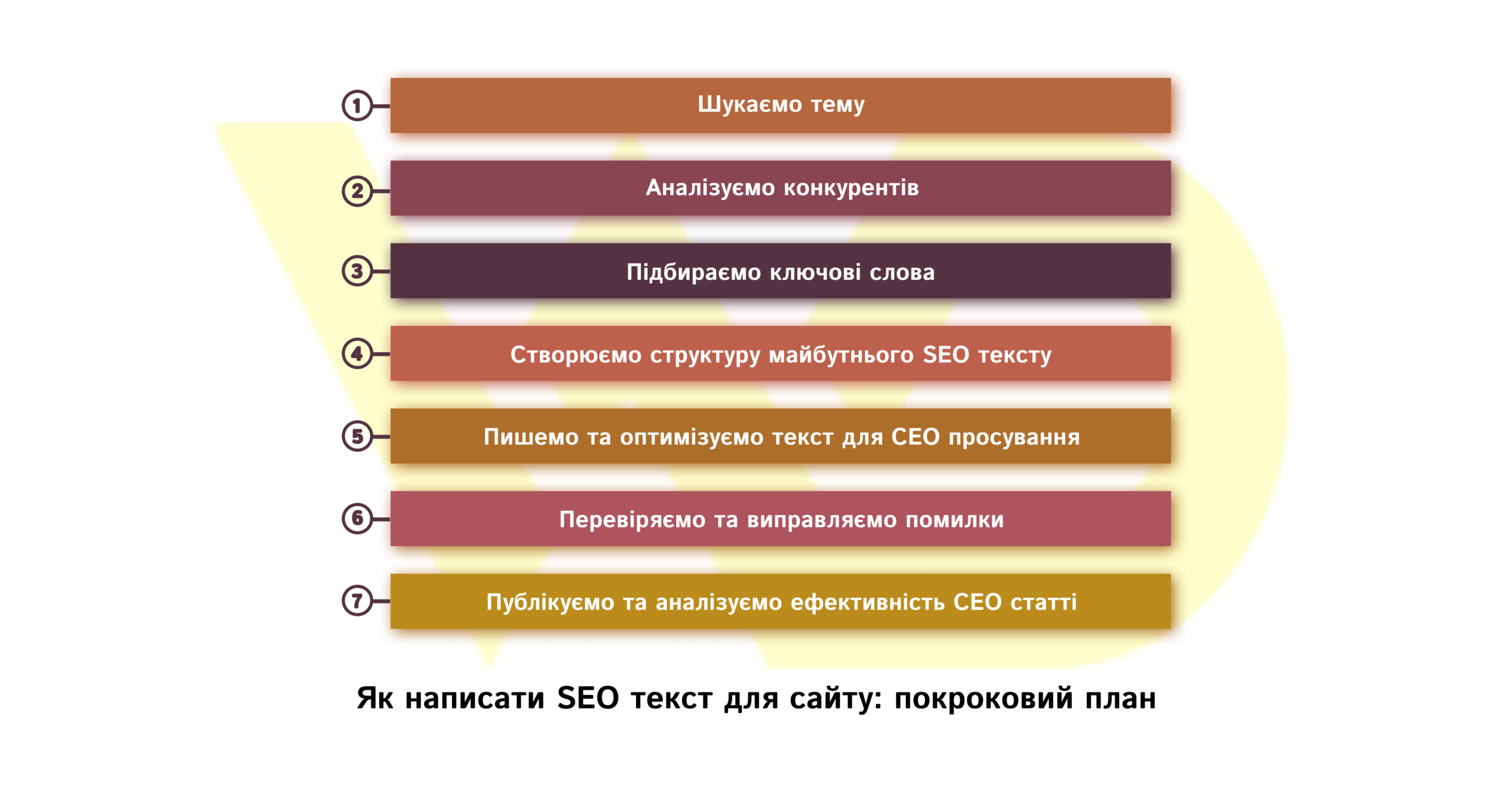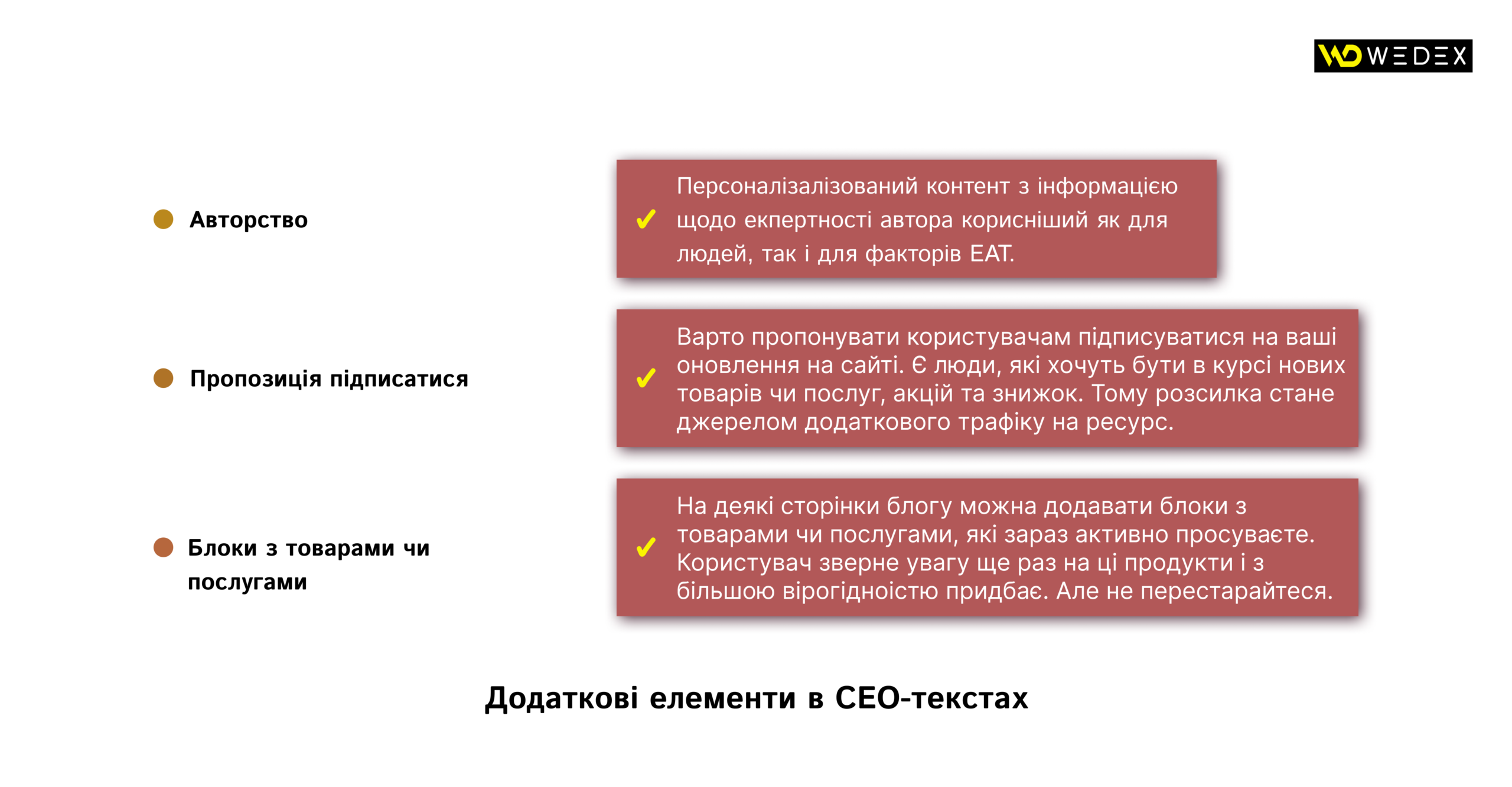Content of the article

SEO is an abbreviation of Search Engine Optimization, which translates as optimization for search engines. In other words, SEO is the process of promoting websites to attract new visitors.

SEO text is one of the tools used for effective SEO promotion websites on the Internet. Thanks to the creation and publication of such optimized texts on the resource, the pages become more relevant and gradually raise the site to the TOP of search results. Such an article must have high uniqueness and extremely useful information for the reader. For businesses, SEO text is interesting because it helps attract a lot of organic traffic to the site from the search engine, prompts users to take a targeted action on the page, and increases conversions from the web resource.
Optimization SEO articles represents its saturation with key queries and compliance with certain parameters depending on the current algorithms of the search engine.
In this article, we will analyze what are the rules for writing materials for sites, so that they are really high-quality and effectively promote the web resource, minimizing advertising costs.
How does SEO text differ from ordinary text?
Texts sharpened for SEO promotion are created by professional copywriters. When writing, they take into account the current requirements of search engines at the time of writing, analyze and cover the pain points and needs of potential readers. When creating a regular text on a certain topic, all these nuances are not taken into account.
Rules for creating SEO texts
In order to understand how a competently created article for SEO promotion should look, you need to know what it consists of and what rules it is written according to. So, there are elements that indicate that the material is written specifically for Search Engine Optimization.

1. The first and most important thing is the uniqueness of the material
All the following points are not important if the article is not unique. Search engines ban web resources that host content copied from competitors. And if it is not so critical for images and videos, then identical text will immediately drag down your site.
Special services are used to analyze the new text, which show uniqueness in the format of percentages. It is ideal when it is 100%, but this cannot always be achieved. Therefore, it should be borne in mind that the article must have a uniqueness of at least 90%, and for specific materials with a large number of terms, this mark can decrease to 75%.
2. The presence of keywords and phrases
With the help of special programs, the SEO specialist selects a semantic core for the site, which includes many key queries that potential visitors to the resource can enter in the search engine search line. After their clustering (separation of the entire mass of keys on the pages of the web resource), a technical task for SEO texts is written for a copywriter who creates a high-quality article with the number of keywords and phrases specified by the SEO specialist. Thanks to the coordinated work of these specialists, search algorithms understand that the article meets the needs of users and is useful, and promotes it.
3. The article is relevant and useful
Compared to plain text content, SEO optimized content answers specific questions that the reader has. That is, writing always has a purpose, and the search engine clearly monitors the quality of articles.
The addition of LSI keys has a positive effect. Latent Semantic Indexing is words and phrases that are related to direct queries, but are not. For example, if the user’s main request is “site promotion”, then LSI phrases can be “site design”, “SEO promotion”, “how to get the site to the TOP” and others.
4. Clear structure
SEO text always has a clear and understandable structure. It includes a hierarchy of headings from H1 to H6, but H1, H2, H3, less often H4 and further are used.
- H1 – the title of the article, which reflects its essence;
- H2 – sub-headings or second-level headings, there can be 2 or more of them, depending on the total volume;
- H3 is a third-level heading that is placed inside the text with a second-level heading;
- H4 and further – subheadings in H3 headings, but they are, in fact, used very rarely.
Also mandatory are a block structure with small paragraphs, the presence of lists (numbered and marked) to improve the perception of the material, the selection of particularly important nuances that are worth paying attention to.
Such structuring gives search bots the opportunity to understand what the material is about, and users – easier and faster to perceive and find the necessary information.
Do you want more customers?
Enhance your website with quality content! Order SEO copywriting from WEDEX and rise in the search engines. We will create texts that will attract your target audience and increase sales.
5. Image in text
When the article is illustrated, it has added photos, pictures, infographics, tables and creative banners that correspond to the content and complement it, such material is much more interesting for users to study. Search engines also respond positively to images when ranking a web resource in the output.
6. Video materials as an addition and expansion of the text
This element is not used that often, but it is interesting because it keeps visitors longer on the site, which improves its position in the search results.
7. Quotes
Adding quotes from famous people, experts in the niche helps to make the material more alive and truer. Quotes always grab attention, they are an intriguing start to a paragraph and a conditional “air” in the middle of an SEO text.
8. Internal linking in the article
In SEO texts, there are words in which links to other materials within the same web resource are sewn. For example, in the article Facebook promotion for business in the words “target audience» sew a link to the article Analysis of the target audience.
9. Technical parameters
Not only uniqueness is important, but also other SEO parameters. It checks for nausea, uniqueness, keyword frequency and, of course, grammar. We will analyze this in more detail later.
10. Use of meta tags
Meta tags are title and description, which are created individually for each material depending on its content and goals. They are invisible to readers, but are read by robots and are very important for the site’s ranking in the search results.
11. Compliance with the E-E-A-T principle
The content should not only be useful and meet the user’s request, but also be safe. For the last few years, Google’s algorithms have been working with this principle in mind.

Let’s take a look at what this means.
- E (experience) – when the copywriter writes about the benefits of vegetables for the body and adds his own experience, how he fixed the work of the stomach with the help of eating vegetables, the weight of the material immediately becomes greater. Both the reader and Google have more trust in such content. Add to the text your own experience or colleagues, acquaintances, describing the situation, the problem and the solution.
- E (expertise) means that the author has in-depth knowledge of the topic of the article. For example, legal texts are better written by a person with appropriate education and competence. Thus, the material will be technically correct and will fully reveal the nuances of the topic. The site will rank higher.
- A (authority) – Google evaluates how authoritative a web resource is by counting the number of links to it from third-party sites and the authority of these sources. The more quality links – the higher the search engine promotes your resource.
- T (reliability) is a parameter formed based on the assessment of the level of trust in the site or SEO copywriter. Google analyzes the reputation of the web resource and technical aspects, such as the transparency and comprehensibility of posted information about the company (including address, telephone numbers), compliance with privacy rules, site safety. A site with positive reviews and an SSL certificate is considered reliable.
So, creating an SEO article is a rather complex process that includes many stages, but in the long run, this tool significantly improves the site’s position in search results and attracts interested users to the web resource for free.
But having an understanding of the rules for creating SEO articles is not enough to write high-quality, optimized content. Let’s consider step by step how to create such content.
How to write SEO text for a site?
A step-by-step work plan will make the SEO text writing process much faster and easier. If you use it, creating or proofreading an article written by a copywriter will not cause any difficulties.

We are looking for a topic
If the SEO specialist did not provide a technical task with a specific topic, it is worth analyzing the already existing content of the blog or section on the site where the text is needed.
Please note that the topic should be relevant not only for the web resource, but also for potential readers. You can use the service to analyze popularity Google Trends and see the dynamics of the relevance of the selected topic (headline).
It is logical that, under the condition of positive dynamics, you can safely take the title for writing SEO text.
We analyze competitors
The next step is to research articles on competing sites. View themes, design, and view statistics. It will not hurt to find the pages in the social networks of competitors and to analyze the activity and engagement of the target audience in the profiles.
With the help of special services, we collect keywords and phrases that are most often used on other sites and check their relevance.
We select keywords
Having already some data, it is easier to collect the keys for your own effective SEO material. There should be at least 3 main high-frequency keywords in the article, and a maximum of 15 additional keywords that define the topic.
There are services tested by time and by many SEO promotion specialists that help to collect semantics for SEO text. Among them:
- Google Ads helps to collect keys and calculates the required frequency of use;
- Serpstat conducts an audit of competitors’ sites, researches keywords and clusters them, and also offers content generation by artificial intelligence;
- Keywordtool one of the few completely free online tools that analyzes and collects relevant long keywords using Google’s autocomplete;
- Ahrefs contains a lot of SEO tools in itself, including the search for key queries and analytics of web resources;
- SEMrush qualitatively audits the content and provides recommendations for its optimization.
An important nuance! It is necessary not only to choose technically competent semantics, but also to evenly distribute key phrases throughout the text. They should not all be in a pile: the longer the material, the less often keys should occur in the total mass. For a guideline, you can take 1 request for every 500 characters, but everything is calculated depending on many parameters of the SEO article.
We create the structure of the future SEO text
Usually, if the article is not very large in volume, then the structure is as follows:
- heading H1;
- introductory paragraph;
- first subheading H2;
- second subheading H2;
- сonclusion.
A little above, we have already analyzed what the headings H1-H4 mean and what they should be. Now about the content.
- The introduction is a short paragraph that briefly reveals the essence of the topic and what exactly the reader will learn from the material.
- The text after the first subheading H2 already contains a detailed description of the topic, all details and problems.
- Next, in the second subheading H2, we give the solution. SEO copywriting aims to answer all the questions that the reader may have, not only when he was looking for an article, but also during the reading process. Then the material is considered high-quality.
- The conclusion summarizes all the information and gives a concise answer to the questions that were promised to be revealed in the introduction. If it makes sense, then the terms of cooperation are added (registration, delivery and payment of the order or a description of how to get the service).
This is a very approximate scheme for SEO text, which, as a rule, is expanded and supplemented to fully reveal the topic. The only place where this scheme fits perfectly is product and service descriptions in online stores, short blog articles.
We write and optimize text for SEO promotion
When all the necessary data is collected, there are no questions about how and what to write. And most importantly, there is no problem of a blank sheet when the author sits, looks at a blank page on the screen and does not know where to start.
Of course, we remember the need to use collected key queries. Some copywriters write and immediately add them to the text, others first reveal the topic of all headings, and then conduct an analysis of how many more keys need to be added. Then they are organically entered, guided by the following rules:
- high-frequency keywords are located at the beginning of the SEO article, and the most important – in the first two sentences;
- it is important to add keywords or phrases to headings and subheadings and to be guided by the principle: the higher the heading is in the hierarchy, the greater the frequency of the key used in it;
- mandatory uniform distribution of all requests throughout the text material, including in marked, numbered lists, tables, etc.
Despite the fact that this is SEO copywriting, it is worth paying attention to the organicity of the incoming requests. The reader should not understand and clearly see where the key was used. And also carefully monitor their number, because an oversaturation of keywords will sooner drag the site down in the ranking than up.
We check and correct errors
In companies that give the task of writing SEO texts to full-time authors or freelancers, there is an editor who reads the article after it is submitted by the author and corrects minor errors. In this way, the material is brought to the ideal in order to be published in the future. However, the author himself must also reread and check the compliance of the text with the given parameters.
There is something that is always checked, regardless of the specifics of the material. These are grammar, spelling, stylistics, the correct use of terms, the veracity of all information, in particular the specified dates and events. Also, the logic of the structure and the correspondence of the headings and the text below them. It may seem that this is not the most important thing, but illogical, unreadable material is a path to the abyss.
The next step is to check the technical parameters that the SEO article must meet in order to meet the requirements of search algorithms. Most often, the analysis is carried out:
- uniqueness, that is, its originality (must reach 90-100% for ordinary text, from 75% for technical text with a large number of terms);
- swelling or nausea (normally – 30-60%, shows the frequency of key repetitions);
- water content (a good indicator is up to 15%, meaning the concentration of meaningless words relative to the entire text).
All this is checked in online services such as Grammica, Unicheck, DupliChecker, Serpstat, Copywritely, Istio.
We publish and analyze the effectiveness of the SEO article
Publication is certainly not included in the concept of creating a text, but it is an integral stage. This is done by the author or a separate person – a content manager. When uploading, you need to remember all the prepared elements: text, infographics, photos and other images, video materials – and place them organically on the page.
We also add the meta tags we mentioned above. The main ones that are always used and affect the ranking of web resources in the search engine are the Title tag (a title up to 60 characters long) and the Description meta tag (a short description of the page up to 300 characters long). Tags are needed so that the search engine receives additional information about the site page. There are tags that are added to certain elements, for example, <ALT> is used when captioning an image, <h1>-<h6> – for subheadings, <table>…</table> – for tables, <ul>…</ul> and <ol>…</ol> – at the beginning and end of numbered and bulleted lists, etc.
Analysis of the effectiveness of the SEO text is necessary to understand how correctly the preparatory work was carried out and the article was written. The main question is whether the material helped to attract more users and lead them to the target action? To see this, the analysis takes into account:
- the number of readers who viewed the page;
- from where they got to the web resource;
- parameter of received attendance;
- the time the person was on the site;
- the percentage of readability of the material;
- the frequency of viewing the article to the end;
- user transitions between pages.
And the analysis necessarily includes data on changes in resource positions after the publication of each specific SEO material.
Additional elements in SEO texts
We’ve covered many features for creating quality, optimized content. But there is always a way to improve the result using unexpected methods for the user.

This is not done on all sites, so there is a chance to stand out among competitors.
How much does SEO text cost?
Competently written texts are a very powerful tool, because they can bring a large amount of organic traffic to the site every day without constant additional financial investments.
You can get high-quality SEO texts for successful site promotion only with the help of experienced specialists:
- an SEO specialist who will conduct a competitor analysis, collect a semantic core and write the correct technical task for the author;
- a copywriter who will create unique, useful content taking into account the necessary technical parameters of the material;
- a proofreader who will check and correct minor errors after the author (because no one canceled the human factor).
Having chosen a team of professionals, you should not skimp on their services. After all, the number of your sales and income ultimately depends on their motivation.
The price may vary depending on where you order these services: a freelancer is a little cheaper, and an agency is more expensive. For example, the cost of SEO copywriting on a freelance basis starts from UAH 70-80 per 1,000 characters of unique text, and in an agency – from UAH 100-120 per 1,000 characters. However, there are pros and cons everywhere.
To summarize
Many people think that creating SEO text is something very easy and quick to do. But, as we found out in this article, the process requires a lot of knowledge and skills, considerable experience, the ability to quickly respond to trends in SEO and changes in search engine algorithms.
An effective SEO article has the right structure and the optimal number of key queries, evenly distributed throughout the material. Pictures, infographics, videos, and other elements are also optionally added. When writing, the copywriter adheres to the principles of E-E-A-T, which makes the content even more persuasive for readers.
Text optimized for the search engine will become a tool for the business owner’s website, which in the long run will help it get to the top of the results, leaving competitors far behind.







 04/12/2024
04/12/2024  5191
5191


